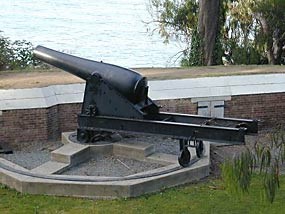
For hundreds of years, artillery material was patterned in a complexity of curved, angular, and linear shapes, along with moldings and rings of various widths, knobs, and handles. Although these features supposedly contributing to the overall strength of the cannon, they were in large part purely ornamental. Some of this adornment gradually disappeared over the centuries, but it was only in the 1850s that experiments with sound indicated that such ornamentation increased the likelihood of cannon failure. One of the men involved in these studies was Thomas J. Rodman, an Army Ordnance officer who was to become famous for several important contributions in the fields of armament design, metallurgy, and explosives. Since the 1840s Rodman had been involved in studying gun strengthening factors, one of which proved to be his greatest contribution to the advancement of heavy armament in the United States. It had been determined that in the casting of large iron cannon, the sequence of cooling and hardening, which began at the outer surface and progressed toward the interior, left the finished gun under a pattern of stress directed to the exterior. Since the pressures associated with firing were also directed radially outward from the bore, the total stress at the moment of firing sometimes exceeded the gun's limit of strain and caused the weapon to burst. Rodman's solution was to reverse the pattern of stresses accumulated in the course of cooling by solidifying his castings in the opposite direction; by circulating cold water through the hallow core of a casting while keeping the exterior heated, so that the hardening sequence was from the bore toward the outside. The net effect was that the firing of guns cooled in this manner actually reduced rather than increased the total stress on their metal. This method of casting iron had negligible effect with regard to smaller weapons, such as those used in field artillery, but its effectiveness increased in direct proportion with the mass of iron involved in the cannon. Under Rodman's system of casting it became possible to produce one-piece iron guns in calibers as large as 15 and 20 inches. Rodman cannons are currently on display at Fort Point, Fort Mason and the Presidio. Resources Lewis, Emanuel R. Seacoast Fortifications of the United States: An Introductory History. Pictorial Histories Publishing Company, 1990. |
Last updated: January 9, 2017
